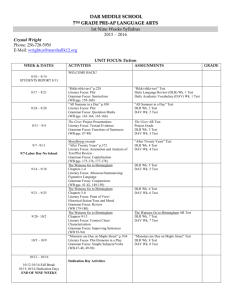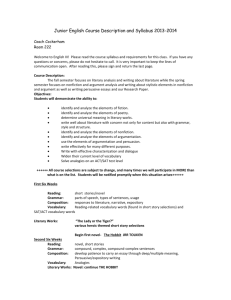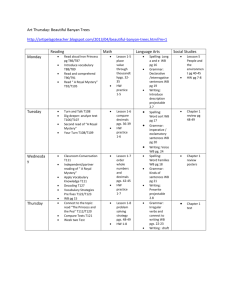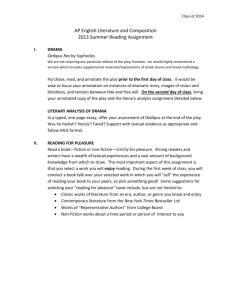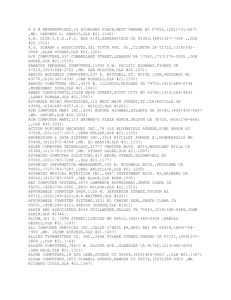2nd_9_wks_Syllabus_7th_Grade_Pre-AP
advertisement
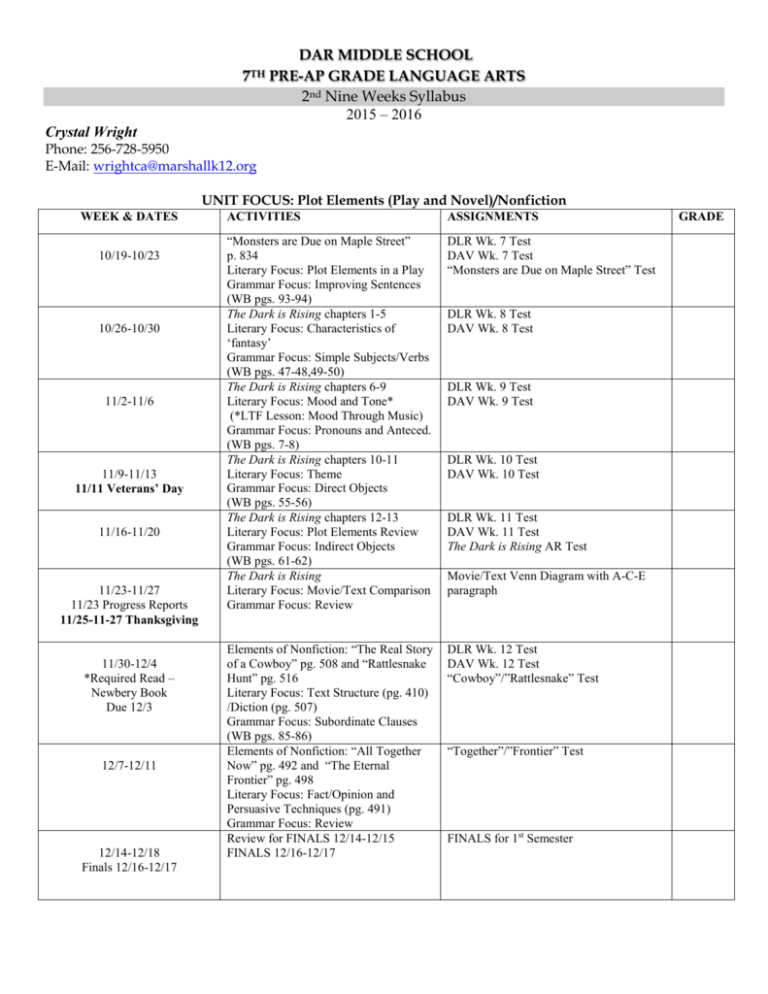
DAR MIDDLE SCHOOL 7TH PRE-AP GRADE LANGUAGE ARTS 2nd Nine Weeks Syllabus 2015 – 2016 Crystal Wright Phone: 256-728-5950 E-Mail: wrightca@marshallk12.org UNIT FOCUS: Plot Elements (Play and Novel)/Nonfiction WEEK & DATES 10/19-10/23 10/26-10/30 11/2-11/6 11/9-11/13 11/11 Veterans’ Day 11/16-11/20 11/23-11/27 11/23 Progress Reports 11/25-11-27 Thanksgiving 11/30-12/4 *Required Read – Newbery Book Due 12/3 12/7-12/11 12/14-12/18 Finals 12/16-12/17 ACTIVITIES ASSIGNMENTS “Monsters are Due on Maple Street” p. 834 Literary Focus: Plot Elements in a Play Grammar Focus: Improving Sentences (WB pgs. 93-94) The Dark is Rising chapters 1-5 Literary Focus: Characteristics of ‘fantasy’ Grammar Focus: Simple Subjects/Verbs (WB pgs. 47-48,49-50) The Dark is Rising chapters 6-9 Literary Focus: Mood and Tone* (*LTF Lesson: Mood Through Music) Grammar Focus: Pronouns and Anteced. (WB pgs. 7-8) The Dark is Rising chapters 10-11 Literary Focus: Theme Grammar Focus: Direct Objects (WB pgs. 55-56) The Dark is Rising chapters 12-13 Literary Focus: Plot Elements Review Grammar Focus: Indirect Objects (WB pgs. 61-62) The Dark is Rising Literary Focus: Movie/Text Comparison Grammar Focus: Review DLR Wk. 7 Test DAV Wk. 7 Test “Monsters are Due on Maple Street” Test Elements of Nonfiction: “The Real Story of a Cowboy” pg. 508 and “Rattlesnake Hunt” pg. 516 Literary Focus: Text Structure (pg. 410) /Diction (pg. 507) Grammar Focus: Subordinate Clauses (WB pgs. 85-86) Elements of Nonfiction: “All Together Now” pg. 492 and “The Eternal Frontier” pg. 498 Literary Focus: Fact/Opinion and Persuasive Techniques (pg. 491) Grammar Focus: Review Review for FINALS 12/14-12/15 FINALS 12/16-12/17 DLR Wk. 12 Test DAV Wk. 12 Test “Cowboy”/”Rattlesnake” Test DLR Wk. 8 Test DAV Wk. 8 Test DLR Wk. 9 Test DAV Wk. 9 Test DLR Wk. 10 Test DAV Wk. 10 Test DLR Wk. 11 Test DAV Wk. 11 Test The Dark is Rising AR Test Movie/Text Venn Diagram with A-C-E paragraph “Together”/”Frontier” Test FINALS for 1st Semester GRADE The teacher may give additional tests, quizzes or assignments at his/her discretion. Students should see the teacher for specific dates and times of what was covered during an absence from class. The teacher reserves the right to modify this schedule as needed. Students are responsible for knowing about modifications announced in class. Course of Study 11. Determine two or more central ideas in a text and analyze their development over the course of the text; provide an objective summary of the text. [RI.7.2] 12. Analyze the interactions between individuals, events, and ideas in a text (e.g., how ideas influence individuals or events, or how individuals influence ideas or events). [RI.7.3] 13. Determine the meaning of words and phrases as they are used in a text, including figurative, connotative, and technical meanings; analyze the impact of a specific word choice on meaning and tone. [RI.7.4] 15. Determine an author’s point of view or purpose in a text and analyze how the author distinguishes his or her position from that of others. [RI.7.6] 17. Trace and evaluate the argument and specific claims in a text, assessing whether the reasoning is sound and the evidence is relevant and sufficient to support the claims. [RI.7.8] 20. Write arguments to support claims with clear reasons and relevant evidence. [W.7.1] a. Introduce claim(s), acknowledge alternate or opposing claims, and organize the reasons and evidence logically. [W.7.1a] b. Support claim(s) with logical reasoning and relevant evidence, using accurate, credible sources and demonstrating an understanding of the topic or text. [W.7.1b] c. Use words, phrases, and clauses to create cohesion and clarify the relationships among claim(s), reasons, and evidence. [W.7.1c] d. Establish and maintain a formal style. [W.7.1d] e. Provide a concluding statement or section that follows from and supports the argument presented. [W.7.1e] 21. Write informative or explanatory texts to examine a topic and convey ideas, concepts, and information through the selection, organization, and analysis of relevant content. [W.7.2] a. Introduce a topic clearly, previewing what is to follow; organize ideas, concepts, and information, using strategies such as definition, classification, comparison or contrast, and cause and effect; include formatting (e.g., headings), graphics (e.g., charts, tables), and multimedia when useful to aiding comprehension. [W.7.2a] b. Develop the topic with relevant facts, definitions, concrete details, quotations, or other information and examples. [W.7.2b] c. Use appropriate transitions to create cohesion and clarify the relationships among ideas and concepts. [W.7.2c] d. Use precise language and domain-specific vocabulary to inform about or explain the topic. [W.7.2d] e. Establish and maintain a formal style. [W.7.2e] f. Provide a concluding statement or section that follows from and supports the information or explanation presented. [W.7.2f] 23. Produce clear and coherent writing in which the development, organization, and style are appropriate to task, purpose, and audience. (Gradespecific expectations for writing types are defined in standards 20-22 above.) [W.7.4] 27. Gather relevant information from multiple print and digital sources, using search terms effectively; assess the credibility and accuracy of each source; and quote or paraphrase the data and conclusions of others while avoiding plagiarism and following a standard format for citation. [W.7.8] 28. Draw evidence from literary or informational texts to support analysis, reflection, and research. [W.7.9] a. Apply Grade 7 Reading standards to literature (e.g., “Compare and contrast a fictional portrayal of a time, place, or character and a historical account of the same period as a means of understanding how authors of fiction use or alter history”). [W.7.9a] 28b. Apply Grade 7 Reading standards to literary nonfiction (e.g., “Trace and evaluate the argument and specific claims in a text, assessing whether the reasoning is sound and the evidence is relevant and sufficient to support the claims”). [W.7.9b] 31. Analyze the main ideas and supporting details presented in diverse media and formats (e.g., visually, quantitatively, and orally) and explain how the ideas clarify a topic, text, or issue under study. [SL.7.2] 33. Present claims and findings, emphasizing salient points in a focused, coherent manner with pertinent descriptions, facts, details, and examples; use appropriate eye contact, adequate volume, and clear pronunciation. [SL.7.4] 36b. Explain the function of phrases and clauses in general and their function in specific sentences. [L.7.1a] 37a. Use a comma to separate coordinate adjectives (e.g., It was a fascinating, enjoyable movie but not He wore an old [,] green shirt). [L.7.2a] 39c. Consult general and specialized reference materials (e.g., dictionaries, glossaries, thesauruses), both print and digital, to find the pronunciation of a word or determine or clarify its precise meaning or its part of speech. [L.7.4c] 40b. Use the relationship between particular words (e.g., synonym/antonym, analogy) to better understand each of the words. [L.7.5b]
